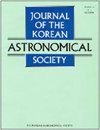太阳磁场特征相消的磁重联模型评述
IF 0.8
4区 物理与天体物理
Q3 ASTRONOMY & ASTROPHYSICS
引用次数: 4
摘要
数据分析和理论论证支持色球电流片中的磁重联是观测到的太阳光球磁通量抵消的机制。斯威特·帕克电流片中的磁堆重联可以解释观测到的消磁特性,包括消磁碎片的速度、碎片中的磁通量和从数据推断出的磁通量消率。讨论了如何通过放宽可忽略的电流片曲率和光球上方的重联点高度恒定的假设来建立更现实的色球重联模型。本文章由计算机程序翻译,如有差异,请以英文原文为准。
COMMENTS ON MAGNETIC RECONNECTION MODELS OF CANCELING MAGNETIC FEATURES ON THE SUN
Data analysis and theoretical arguments support magnetic reconnection in a chromospheric current sheet as the mechanism of the observed photospheric magnetic flux cancellation on the Sun. Flux pile-up reconnection in a Sweet{Parker current sheet can explain the observed properties of canceling magnetic features, including the speeds of canceling magnetic fragments, the magnetic uxes in the fragments, and the flux cancellation rates, inferred from the data. It is discussed how more realistic chromospheric reconnection models can be developed by relaxing the assumptions of a negligible current sheet curvature and a constant height of the reconnection site above the photosphere.
求助全文
通过发布文献求助,成功后即可免费获取论文全文。
去求助
来源期刊

Journal of the Korean Astronomical Society
地学天文-天文与天体物理
CiteScore
1.30
自引率
10.00%
发文量
0
审稿时长
>12 weeks
期刊介绍:
JKAS is an international scientific journal publishing papers in all fields of astronomy and astrophysics. All manuscripts are subject to the scrutiny of referees. Manuscripts submitted to JKAS must comply with the ethics policy of JKAS. Six regular issues are published each year on February 28, April 30, June 30, August 31, October 31, and December 31. One year''s issues compose one volume.
 求助内容:
求助内容: 应助结果提醒方式:
应助结果提醒方式:


